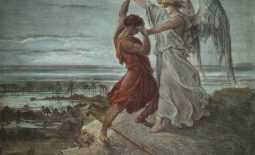Salt and Ice
My kids are now of an age where they are captivated by Disney movies and the compelling narratives of fairytales. My oldest and I have had several philosophical conversations on the nature of ‘truth’: he asks me whether fairytales are real, and I have responded to him that things may not be real – as in factual and empirical – but can still be true – as in the values they hold and the ideas they drive. It is a hard distinction to understand for a six-year-old, but as a liberal Rabbi, I am a great believer in intellectual honesty. We can affirm the Torah’s deep truth while questioning its factuality, not unlike the great moral tales of our culture.
With this in mind, we started watching ‘Frozen’, the great Disney blockbuster from 2013. The story is basically a ‘Midrash’ on the story of the ‘Snow Queen’ written by Hans Christian Andersen. I remember reading The Snow Queen as a child; I had an old volume of Anderson’s tales, in a faded red linen cover, and I devoured their imagery and symbology. What makes Frozen a remarkable example in the Disney universe, for those of you who haven’t seen it, is that the story is driven entirely by two women, who are sisters. There is no salvific appearance of a handsome prince – it is a film that passes the Bechdel test. The Bechdel test is a determinant to see if women have true agency by examining whether there is a single conversation in the story between women that does not center on a man. The story is about two royal sisters of a small Nordic Kingdom; Elsa and Anna. Elsa, the older sister and heir to the throne, is in possession of and possessed by, a type of ice magic. Like a Nordic Midas, everything she touches turns to ice. This has tragic consequences as it severs the relationship between the two loving sisters and causes isolation and fear for Elsa, who is quite literally, ‘frozen’.
As I was studying the Parashah and as a continuation of last week’s sermon, wanted to delve deeper into the family dynamics of Lot, a focus on Lot’s wife who turns into a pillar of salt would be interesting. Then it struck me: Lot’s wife too, like Elsa, is ‘frozen’, and in the spirit of all archetypical stories, we are invited to peel back the layers of abstraction to try and understand what this means.
The Torah crafts a number of characters in Abraham’s orbit, who are all, in some way deficient. This is a clever literary device, of course, as it elevates Abraham (who we know is also flawed). Glancing back through the generations, we have Noah. Adjacent to Abraham, we have his nephew Lot. Issuing from Abraham, we have Yishmael. Noah is paralyzed by passivity, the Lot, consumed by greed and Yismael, driven by violence. To answer the question posed in last week’s sermon: in the imagination of the Torah, Abraham is considered the true measure of a man. If we zoom in on these characters, we see that the women in the orbit of this Biblical patriarchy don’t pass the Bechdel test: they are entirely dependent on the wiles and whims of the men in their lives. Hagar is victimized and Noah’s and Lot’s wives don’t even have voices. Lot’s daughters, tragically and repulsively, are driven by fear and commit an unspeakable act of incest, resonant of the drunken episode of Noah after the flood. Only Sarah is an agent in her own right.
After Lot reprehensibly offers his daughters to be violated by the denizens of Sodom, and the family is warned, they flee. Lot isn’t keeping it together anymore, and as they run, Lot’s wife glances back and is turned into a pillar of salt. The picture that the Torah paints is of a pitiful man who lacks moral backbone. Yet, the true victim of his lack of fortitude is his unnamed wife. When the messengers tell Lot to leave the city instantly, this message is not conveyed directly to the wife and daughters. The Women’s Torah commentary picks up on this notable omission by examining the Hebrew: ‘Himalet al nafshecha, al tabit achareicha’ – ‘flee for your life, do not look behind you.’ Not only did the verse not explicitly address the women, it didn’t address them implicitly either, since the grammar in in the masculine singular. The commentary states:
It may be construed that they were spoken only to Lot.
His wife looked behind him – This is precisely what Lot is warned against. Nowhere does the text indicate that he passes this information to his wife and daughters.
There is an echo of the Garden of Eden in here – Lot’s wife wasn’t addressed directly in the commandment to not glance back, just like Eve wasn’t addressed directly in the prohibition to not eat from the Tree of Knowledge of Good and Evil. There’s something else going on here: when the text tells us that Lot’s wife glanced back, it says that she looked behind him. Behind him and not behind herself? Usually a person looks back over their own shoulder, but the image we get is of a woman cowering behind her husband’s shoulder. Her agency is further reduced.
We often focus on the heroics (or lack thereof) of the male characters, but what of the female ones? What is the connection between Lot’s wife and the Disney character of Elsa? On a certain level the comparison seems facetious, even infantile, but if we go with the premise of moral tales revealing deeper truths, there is wisdom to be found even here. Perhaps it is the universal fear of frozenness; of being locked in, being disempowered, being morally neutered. This is the hallmark of people who have no agency, who in the words of our tradition ‘have a heart of stone’ that needs to be turned into a heart of flesh. Lot’s wife and daughters were driven by fear, not by hope, and the outcome of that fear is moral paralysis. The question for all of us, irrespective of gender, is what true moral agency means and how we can learn from the failings of Lot and triumphs of Abraham.
Only then can we overcome the pillars of salt in our own lives.




